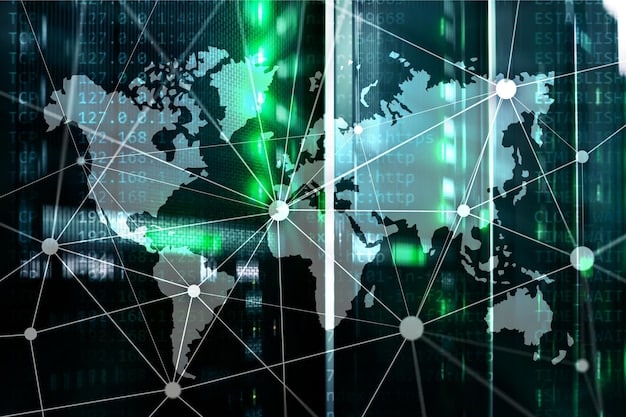US Critical Infrastructure Cyberattack: Key Alerts & Protection Strategies

US critical infrastructure is facing increasingly sophisticated cyberattacks, posing significant risks to national security and essential services; understanding the threats and implementing robust cybersecurity measures is paramount to protecting these vital assets.
The United States’ critical infrastructure is under constant threat of cyberattack, and the sophistication of these attacks is ever-increasing. Understanding the nature of these threats and how to mitigate them is now more important than ever. This article dives into what you need to know about the current cybersecurity landscape and what actions can be taken to protect these vital assets. Alert: US Critical Infrastructure Under Cyberattack – What You Need to Know is essential for anyone involved in cybersecurity, government, or simply concerned about the stability of essential services.
Understanding the Scope of the Threat
The digital age has brought about unparalleled connectivity, but it has also opened doors to new vulnerabilities. Critical infrastructure in the United States, which includes sectors like energy, water, communications, and transportation, faces constant cyber threats. Recognizing the breadth and depth of these threats is the first crucial step in bolstering cybersecurity defenses.
What Constitutes Critical Infrastructure?
Critical infrastructure is comprised of systems and assets, whether physical or virtual, so vital to the United States that the incapacity or destruction of such systems and assets would have a debilitating impact on security, national economic security, national public health or safety, or any combination of those matters.
- Energy sector: Power grids, oil and gas pipelines
- Water and wastewater systems: Treatment plants, distribution networks
- Communications sector: Internet, telecommunications networks, broadcasting
- Transportation sector: Airports, railways, roadways
These sectors are interconnected and interdependent, meaning that a disruption in one area can cascade through multiple sectors, potentially causing widespread chaos.

Common Types of Cyberattacks
A variety of attacks against critical infrastructure aim to disrupt operations, steal sensitive information, or cause physical damage.
- Ransomware attacks: Encrypting data and demanding a ransom for its release
- Distributed denial-of-service (DDoS) attacks: Overwhelming systems with traffic to make them unavailable
- Malware infections: Injecting malicious software to compromise systems
- Supply chain attacks: Targeting vendors and suppliers to gain access to infrastructure
The motivation behind these attacks can range from financial gain to geopolitical objectives, but the outcome is consistently disruptive and damaging.
In conclusion, understanding the scope of cyber-attacks is essential to protect important systems. Being informed about the different sectors involved and the types of attacks that might happen helps to prepare for and prevent these threats.
Recent Cyberattack Alerts and Incidents
Examining recent cyberattack alerts and incidents targeting U.S. critical infrastructure provides valuable insights into current threats and vulnerabilities. These real-world examples often illustrate the evolving tactics and techniques employed by malicious actors aiming to compromise essential services. Staying informed about these incidents is key to maintaining a proactive security posture.
- The Colonial Pipeline ransomware attack: In 2021, a ransomware attack on Colonial Pipeline, a major fuel pipeline operator, caused widespread fuel shortages across the Eastern United States.
- The Oldsmar water treatment plant attack: Also in 2021, an attacker gained access to the water treatment plant in Oldsmar, Florida, attempting to increase the level of sodium hydroxide (lye) to dangerous levels.
- The JBS Foods ransomware attack: Another notable incident was the ransomware attack against JBS Foods, a major meat processor, which disrupted meat production and supply chains.
Each of these incidents highlights the potential for severe consequences when critical infrastructure is compromised.
Detailed analysis of these incidents reveals weaknesses in security protocols and incident response capabilities, which can inform improved strategies for defense.
Lessons Learned
- The importance of strong password management and multi-factor authentication.
- The need for robust network segmentation and monitoring.
- The value of having detailed incident response plans in place.
Cyber attacks are a reality, and constant vigilance is required to protect vital systems from these constant threats. By learning from past events and constantly strengthening security measures, we can improve our ability to defend against and handle future occurrences. Recognizing the significance of these threats is the initial action toward greater cybersecurity preparedness.

Who is at Risk? Specific Sectors and Vulnerabilities
While all sectors of U.S. critical infrastructure are at risk, some face unique vulnerabilities due to their inherent characteristics. Recognizing these specific risks is crucial for tailoring security measures and prioritizing defensive efforts.
Energy Sector
The energy sector relies increasingly on digital systems to manage power generation, transmission, and distribution. Attacks on these systems can lead to widespread blackouts and economic disruption.
Water and Wastewater Systems
Water and wastewater systems are vulnerable to cyberattacks that could compromise water quality, disrupt treatment processes, and even endanger public health.
Healthcare sector
Any kind of digital architecture that stores electronic protected information (ePHI) relating to patient data is at risk. Cyberattacks can impact digital tools used for research, imaging, analysis, telehealth and cloud storage, and can lead to delays in care or even death.
Other Sectors
The communications, transportation, and financial services sectors also face significant cyber threats that could disrupt essential services and have far-reaching economic consequences.
Every industry has unique cybersecurity challenges, and some may be vulnerable to cyberattacks that might affect treatment processes and endanger public health. Cybersecurity policies should be specific in identifying and resolving these vulnerabilities.
Key Vulnerabilities in Critical Infrastructure
- Outdated infrastructure: Many systems rely on legacy technology with known security vulnerabilities.
- Interconnected systems: Dependencies between different sectors create cascading failure risks.
- Insider threats: Malicious or negligent insiders can intentionally or unintentionally compromise systems.
Addressing these vulnerabilities requires a comprehensive approach that includes technology upgrades, robust security policies, and ongoing training for personnel.
Understanding which industries are more susceptible and detecting cybersecurity flaws may help tailor security measures in order to properly combat these risks. It is essential to emphasize preventative measures and constant monitoring in order to ensure the security of vital infrastructure.
Defense Strategies: A Comprehensive Approach
Defending U.S. critical infrastructure from cyberattacks requires a comprehensive and multi-layered approach. This strategy must include technological defenses, policy frameworks, and collaborative efforts to create a robust security ecosystem.
Technological Defenses
Implementing advanced technologies is critical for detecting, preventing, and responding to cyberattacks.
- Intrusion detection and prevention systems: Monitoring network traffic for suspicious activity.
- Endpoint detection and response (EDR) solutions: Analyzing endpoint activity to identify and respond to threats.
- Security information and event management (SIEM) systems: Collecting and analyzing security logs from various sources.
Policy Frameworks
Establishing clear policy frameworks and compliance standards helps ensure that organizations adhere to best practices for cybersecurity.
Collaborative Efforts
Sharing intelligence and coordinating responses among government agencies, private sector organizations, and international partners is key to combating cyber threats effectively.
In conclusion, effective defense strategies must combine technological advancements, policy frameworks, and collaborative efforts to make sure that crucial infrastructures are secure and resistant to cyberattacks. By utilizing a comprehensive approach, organizations can better protect their systems and preserve the reliability of essential services.
The Role of Government and Private Sector Collaboration
The cybersecurity of U.S. critical infrastructure is a shared responsibility between the government and the private sector. Effective collaboration is essential for sharing information, coordinating responses, and developing robust security strategies to protect vital assets.
Government Initiatives
The U.S. government has launched several initiatives to enhance cybersecurity across critical infrastructure sectors.
- Cybersecurity and Infrastructure Security Agency (CISA): Provides cybersecurity expertise and support to critical infrastructure stakeholders.
- National Institute of Standards and Technology (NIST): Develops cybersecurity standards and best practices.
- Department of Homeland Security (DHS): Coordinates federal efforts to protect critical infrastructure.
Private Sector Contributions
The private sector owns and operates a large portion of U.S. critical infrastructure, making their active participation in cybersecurity essential.
Organizations should:
- Invest in cybersecurity technology and training.
- Share threat intelligence with government and peer organizations.
- Participate in industry-specific cybersecurity initiatives.
By working together, the government and private sector can leverage their respective strengths to create a more resilient and secure environment for critical infrastructure.
Coordinated efforts between the government and commercial sector are critical for bolstering the security of vital infrastructure. Working together on strategic cybersecurity initiatives and knowledge exchange ensures a complete and collaborative method for effectively countering emerging cyberthreats.
Staying Ahead of the Curve: Future Trends and Predictions
The cybersecurity landscape is constantly evolving, and staying ahead of the curve requires anticipating future trends and preparing for emerging threats. Keeping abreast of new technologies, tactics, and vulnerabilities will be crucial for maintaining a strong security posture.
Emerging Technologies
As technology continues to advance, the cybersecurity landscape will evolve. Keeping abreast of developing technologies will be essential to mitigating new threats.
- Artificial intelligence (AI) and machine learning (ML): Can be used to automate threat detection and response.
- Internet of Things (IoT): Creates expanded attack surfaces with numerous connected devices.
- Cloud computing: Requires secure migration and management of data and applications.
Predicting Future Threats
- Increased sophistication of ransomware attacks.
- Targeting of industrial control systems (ICS) and operational technology (OT).
- Exploitation of vulnerabilities in supply chains.
Being proactive and adaptable is essential to effectively defend US critical infrastructure against ever-changing cyber threats. By anticipating future patterns and preparing for emerging technologies, institutions can strengthen their protection and contribute to a stronger cybersecurity position.
| Key Point | Brief Description |
|---|---|
| 🚨 Threat Scope | US critical infrastructure constantly faces cyber threats from various sources. |
| 🛡️ Defense | A comprehensive defense strategy includes advanced tech, policy, and collaboration. |
| 🤝 Collaboration | Effective collaboration between government and private sectors is essential. |
| 🔮 Future Threats | Prepare for sophisticated ransomware, ICS targeting, and supply chain exploits. |
Frequently Asked Questions
▼
Critical infrastructure includes essential systems like power grids, water, communications, and transportation. These sectors are vital for security, economic stability, public health, and safety in the U.S.
▼
Common attacks include ransomware, DDoS, malware, and supply chain attacks. Ransomware encrypts data, while DDoS overloads systems. Malware infects systems, and supply chain attacks target vendors.
▼
While all sectors are at risk, energy, water, communications, and healthcare face unique vulnerabilities. Sectors heavily reliant on digital systems and interconnected networks may be more susceptible.
▼
Important defense strategies include advanced tech like IDS and EDR, creating clear policies, and cooperation between government and organizations. Tech, strong policies, and sharing information are crucial.
▼
To stay ahead, monitor emerging technologies like AI and IoT. Organizations must predict future threats, such as sophisticated ransomware. Proactivity and adaptability are essential for effective defense.
Conclusion
In conclusion, safeguarding US critical infrastructure from cyberattacks is a complex challenge that demands constant vigilance. By understanding the scope of the threat, implementing comprehensive defense strategies, and fostering collaboration between government and the private sector, we can enhance the resilience and security of the vital systems that underpin our society.





